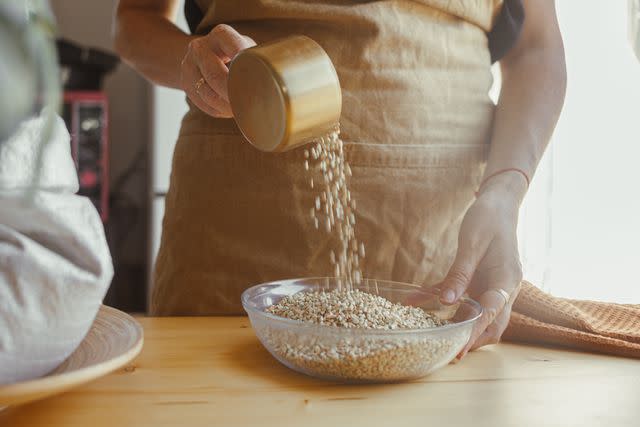Buckwheat: Everything to Know About the Nutritious Seed
Buckwheat is gluten-free and doesn’t contain wheat
Medically reviewed by Elizabeth Barnes, RDN
Despite its name, buckwheat isn’t a wheat or even a grain. Buckwheat is a seed that’s harvested from a flowering plant. It belongs to a group of foods called pseudocereals, which are eaten as cereal grains but don’t grow on grass. Other types of pseudocereals are quinoa and amaranth.
Buckwheat is found in many food products, such as flour, noodles, and breakfast cereals. It has a nutty, earthy taste and a soft texture.
It contains fiber, protein, antioxidants, magnesium, and other nutrients. When added to a balanced diet, buckwheat can provide health benefits, such as improving heart and gut health and regulating blood sugar levels.
This article discusses the nutritional profile of buckwheat, the potential benefits of eating the seed, and how to prepare it.

Alena Shafieva / Getty Images
Buckwheat Nutrition Profile
Buckwheat is richer in minerals and antioxidants than other cereals, such as rice and oatmeal. It also has more protein. One cup of roasted buckwheat groats contains the following:
Calories: 155
Protein: 5.7 grams (g)
Carbohydrates: 33.4 g
Fiber: 4.5 g
Magnesium: 86 milligrams (mg)
Potassium: 148 mg
Phosphorus: 118 mg
Calcium: 12 mg
Iron: 1.34 mg
Vitamin B6: 0.129 mg
Niacin: 1.58 mg
Folate: 23.5 micrograms (mcg)
Vitamin K: 3.19 mcg
What Are Groats?
Groats are buckwheat kernels. They are sold raw or roasted.
Buckwheat is also rich in unique antioxidants, such as rutin and quercetin. Antioxidants help tone down the effects of harmful free radicals in your body.
Additionally, buckwheat contains resistant starches, a type of starch that can pass through the digestive tract without being digested. Some research suggests resistant starches provide specific health benefits, such as lowering blood sugar levels after eating.
Buckwheat Health Benefits
Buckwheat is high in protein, which could help you feel full longer. Including buckwheat in your diet may help with weight management. The additional nutrients in buckwheat can also provide a few key health benefits.
Boosts Heart Health
Buckwheat contains heart-healthy compounds, including rutin and fiber. Some research suggests rutin may lower a person’s risk for heart disease by lessening inflammation and blood pressure. Fiber helps improve cholesterol levels, leading to a lower risk of heart disease and stroke.
Improves Colon and Gut Health
The fiber in buckwheat can help move food through your digestive tract. Fiber is also known to boost good bacteria in the gut and generally is beneficial for colon health. Buckwheat also contains niacin (a B vitamin) that may help promote digestive health.
Buckwheat and Gluten
Buckwheat is a gluten-free food and a good option for people with a wheat allergy or gluten sensitivity.
Regulates Blood Sugar Levels
Buckwheat has been shown to prevent high blood sugar (hyperglycemia). Over time, elevated blood sugar levels can lead to type 2 diabetes. Some animal research has also suggested that extracts in buckwheat may prevent or delay the body’s digestion of sugar. However, more research on humans is needed.
Types of Buckwheat
The two main types of buckwheat grown for food are:
Common buckwheat (fagopyrum esculentum)
Tartary buckwheat (fagopyrum tartaricum)
Typically, Tartary buckwheat contains more nutrients than common buckwheat.
Should Anyone Avoid Buckwheat?
Buckwheat is generally considered a safe food to eat. Although rare, some people with a buckwheat allergy may react to it. They can develop symptoms like hives, skin rashes, digestive issues, or swelling.
If you have food allergies or other dietary restrictions, talking to a healthcare provider before introducing a new food is a good idea.
Where is Buckwheat Grown?
Buckwheat is native to southwest Asia. It’s grown in Russia, China, the northern United States, Japan, the Korean peninsula, Europe, Canada, and other countries.
How to Cook Buckwheat
You can buy buckwheat groats raw or roasted. It’s a good idea to soak and drain the raw groats first to make them easier to digest. Then, you can toast raw kernels in a skillet and add them to side or main dishes. Or, you can boil them in water.
Roasted groats can be cooked just like rice. Easy ways to add buckwheat to your diet include:
Use buckwheat flour to make pancakes or muffins.
Buy products that already contain buckwheat, such as granola or pasta.
Add buckwheat to cereal, fruits, or porridge.
Sprinkle buckwheat on top of salads or soups.
Mix buckwheat in a stir-fry or add to other main dishes.
Summary
Buckwheat is a seed that can provide health advantages when added to a well-balanced diet. It contains fiber, protein, antioxidants, minerals, and other nutrients. Buckwheat's health benefits include improving heart and gut health, helping with weight management, and regulating blood sugar levels.
You can use buckwheat in various ways, including adding it to cereal, salads, soups, and main dishes. While buckwheat is safe for most people, you should ask a healthcare provider if you're prone to food allergies or have other dietary restrictions.
Read the original article on Verywell Health.

